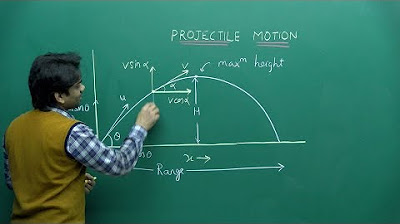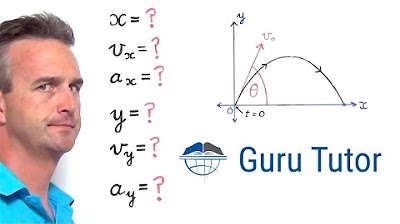Trajectory of a projectile without drag
TLDRThis video script delves into the trajectory of a projectile in the absence of air resistance. It begins by establishing a coordinate system and defining the parameters that influence the projectile's path, such as initial speed and launch angle. The script then methodically breaks down the motion into horizontal and vertical components, using parametric equations to describe the x and y coordinates as functions of time. By combining these equations, a Cartesian equation for the trajectory is derived, revealing a parabolic shape. The script further explains how to calculate the range of the projectile, concluding that the maximum range is achieved when the projectile is launched at a 45-degree angle. This comprehensive analysis provides valuable insights into the physics of projectile motion.
Takeaways
- 🚀 The video discusses the trajectory of a projectile without considering air resistance.
- 📈 The starting point for the analysis is finding parametric equations for the x and y coordinates as a function of time.
- 🔄 The horizontal motion is analyzed first, assuming no acceleration due to the absence of air resistance.
- 🏹 The initial velocity vector is decomposed into horizontal (u cos θ) and vertical (u sin θ) components.
- 📊 The horizontal range (x) is described by the equation x = u cos θ * t, showing a linear relationship with time.
- 🔢 The vertical motion is more complex due to gravity, leading to a quadratic equation for the y coordinate over time.
- 🌐 The Cartesian equation of the trajectory is derived by eliminating time, resulting in an upside-down quadratic equation (parabola).
- 🎯 The range (maximum horizontal distance) of the projectile is found by setting y to zero in the Cartesian equation and solving for x.
- 📈 The expression for the range is simplified to R = (u^2 * sin(2θ)) / g, highlighting the dependence on initial speed and launch angle.
- 📌 The optimal launch angle for maximum range is determined to be 45 degrees, where sin(2θ) is maximized.
- 🔜 The video script sets up for a future discussion on the impact of air resistance on projectile motion.
Q & A
What is the main topic of the video?
-The main topic of the video is the trajectory of a projectile, specifically when there is no air resistance involved.
What are the two key parameters that determine the shape of the projectile's trajectory?
-The two key parameters that determine the shape of the projectile's trajectory are the initial speed (u) and the launch angle (theta).
How does the coordinate system set up for the analysis?
-The coordinate system is set up with the origin at the starting point of the projectile, and the y-coordinate increases upwards while the x-coordinate increases to the right.
What is the horizontal component of the initial velocity?
-The horizontal component of the initial velocity is given by u cos(theta), where u is the initial speed and theta is the launch angle.
What is the equation for the x-coordinate as a function of time?
-The equation for the x-coordinate as a function of time is x = u cos(theta) * t.
How does gravity affect the vertical motion of the projectile?
-Gravity affects the vertical motion of the projectile by providing a constant acceleration downwards, which is represented by the acceleration due to gravity (g) in the equations.
What is the equation for the y-coordinate as a function of time?
-The equation for the y-coordinate as a function of time is y = u sin(theta) * t - 0.5 * g * t^2.
What is the Cartesian equation of the projectile's trajectory?
-The Cartesian equation of the projectile's trajectory is y = (tan(theta) * x) - (g * x^2) / (2 * u^2 * cos^2(theta)).
How can you find the range of the projectile?
-To find the range of the projectile, you set y to zero in the Cartesian equation and solve for x, which gives the maximum horizontal distance the projectile travels.
What is the optimal launch angle for the maximum range of the projectile?
-The optimal launch angle for the maximum range of the projectile is 45 degrees, as this is when sine(2*theta) equals one, giving the maximum possible range.
What will the video in the follow-up cover?
-The follow-up video will cover the case where air resistance is present, and how it affects the trajectory and range of the projectile.
Outlines
🚀 Introduction to Projectile Motion
This paragraph introduces the concept of projectile motion, focusing on the trajectory of a projectile without considering air resistance. The video aims to derive parametric equations for the x and y coordinates as functions of time, which will then be combined to find the Cartesian equation of the trajectory. The starting point is defined as the origin of the coordinate system, and the initial velocity vector is described by its length (u) and angle (theta) relative to the horizontal. The importance of initial speed and launch angle in determining the trajectory is highlighted.
📐 Horizontal and Vertical Components of Motion
In this paragraph, the analysis of projectile motion is broken down into horizontal and vertical components. The horizontal motion is simpler, with no acceleration and a direct relationship between distance (x) and speed times time (x = u*cos(theta)*t). The vertical motion, however, is influenced by gravity, leading to a constant acceleration (a = -g). The parametric equation for the vertical coordinate (y = u*sin(theta)*t - 0.5*g*t^2) is derived using the constant acceleration (suvat) equations. This sets the foundation for further analysis of the projectile's range and the impact of the launch angle on the trajectory.
🎯 Calculating the Range of the Projectile
The final paragraph focuses on calculating the range of the projectile, which is the maximum horizontal distance it travels. By setting the y-coordinate to zero (to represent the point where the projectile hits the ground), the Cartesian equation of the trajectory is used to derive an expression for the range (R = u^2*sin(2*theta)/g). It is discovered that the optimal launch angle for maximum range is 45 degrees, where the sine of 2*theta is maximized. This conclusion is based on the assumption of no air resistance and provides a clear understanding of how the projectile's trajectory can be influenced by its launch angle.
Mindmap
Keywords
💡Projectile Motion
💡Trajectory
💡Air Resistance
💡Parametric Equations
💡Cartesian Equation
💡Range
💡Initial Speed
💡Launch Angle
💡Acceleration Due to Gravity
💡Horizontal Component
💡Vertical Component
Highlights
The video discusses the trajectory of a projectile without air resistance.
The aim is to find parametric equations defining the trajectory's shape.
The x-coordinate and y-coordinate as functions of time are derived.
The Cartesian equation of the trajectory is found by combining results.
The range of the projectile, its total horizontal travel, is determined.
The coordinate system origin is placed at the projectile's starting point.
The initial speed and launch angle are key parameters affecting the trajectory.
The horizontal motion has no acceleration due to lack of air resistance.
The vertical motion is influenced by gravity, leading to a constant acceleration.
The horizontal component of velocity is given by u cos theta.
The vertical component of velocity is u sine theta.
The parametric equations for x and y are derived and labeled as equations 1 and 2.
The Cartesian equation of the trajectory is a parabola, simplified using trig identities.
The range is the maximum horizontal distance the projectile travels.
The range is expressed as a function of the initial speed and launch angle.
The optimal launch angle for maximum range is 45 degrees.
The video sets up the problem and provides a foundation for future discussions on air resistance.
Transcripts
Browse More Related Video

introduction to projectile motion

NEET Physics | Projectile Motion | Theory & Problem-Solving | In English | Misostudy

Projectile Motion (of an Object Fired at an Angle) - A Level Physics

Projectile Motion: Finding the Maximum Height and the Range

Deriving the 6 Basic Projectile Motion Equations

AP Physics - Projectile Motion
5.0 / 5 (0 votes)
Thanks for rating: